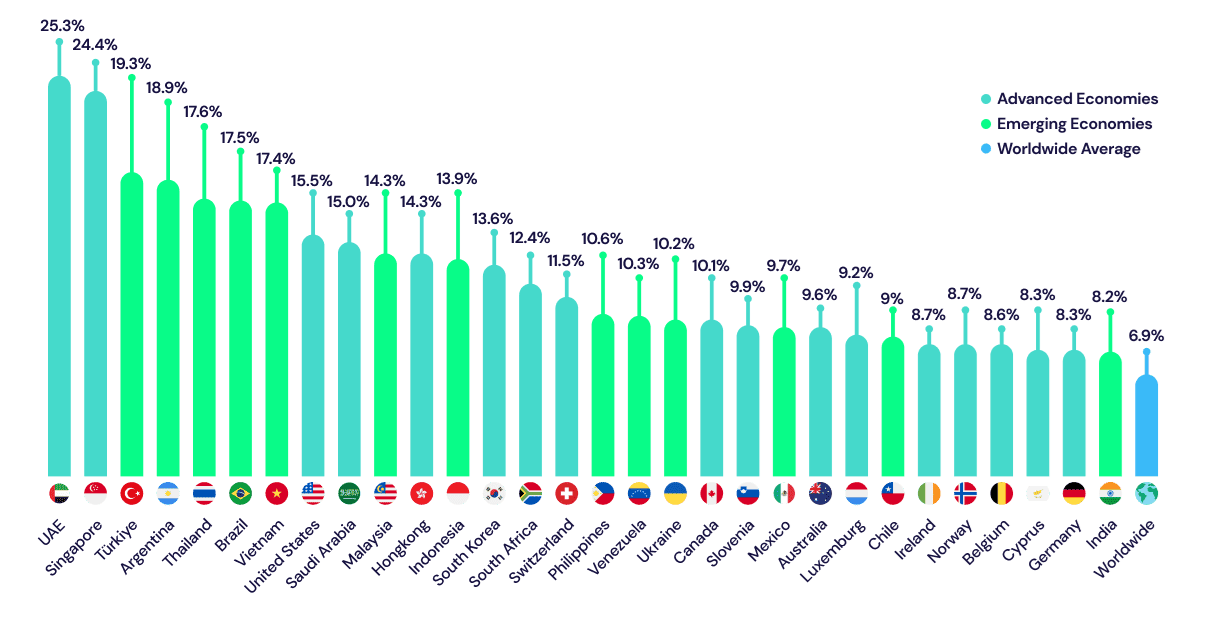Remittance apps are showing a slowing trend in 2024, while stablecoins expanded their supply to new records. As crypto ownership grows, remittance gateways may lose their positions.
Remittance app downloads have slowed down in 2024 after several years of peak activity. They expanded in the past five years, but the latest trends show a reversal of usage.
Matthew Sigel, head of digital assets research at VanEck, believes the shift may benefit stablecoin usage. Acquiring stablecoins is possible through decentralized trading and, in some cases, may not require an initial bank account. Stablecoin transfers are much faster and have virtually negligible fees and no commissions.
The trend of using stablecoins for cross-border purposes has been noticed in the past few years but accelerated during the bull market of 2024. Most of the stablecoin activity is driven by retail remittances, with a smaller share of wholesale cross-border transfers.
Interest in crypto-based remittances may increase in the coming months, as the election of Donald Trump has brought back talks of a remittance tax. Stablecoins are still traceable, but the exact destination and spending may remain difficult to trace.
In the past, projects like Ripple aimed for a share of the remittance market. This time, Ripple hosts RLUSD, a newly minted stablecoin with minimal transaction costs. Solana has also led to an increase in USDC usage. The balance of stablecoins may shift as the Euro Area decreases reliance on USDT and focuses on compliant coins and tokens like USDC.
Remittance market expands, but stablecoins catch up
The remittances market is expected to expand by 3.93% in 2025, retaining a similar pace to its 2024 growth. On the other hand, stablecoins doubled their supply and increased their activity much more dramatically in the past year, both on centralized and decentralized exchanges.
The biggest remittance flows are targeting India, Mexico, China, and the Philippines, which are also some of the most crypto-friendly regions. The availability of stablecoins on multiple chains has avoided the high gas fees on Ethereum, allowing for a viable alternative to the commissions of remittance apps.
In 2024, estimated remittances to the most common destination countries reached $685B. India received $129.1B, becoming the leader in the category.
Stablecoins have the capacity to take a share of the remittance market
Stablecoins easily surpass those amounts, showing a capacity to carry a significant part of the remittances market. According to VISA’s statistics dashboard, stablecoins carried $28.7T in total transfers, including all automated trades. While it is difficult to estimate which transactions were actual remittances, the overall volumes show the ceiling is high, and stablecoins can absorb a big part of the remittance market.
For the past 12 months, the stablecoin market has seen an increased usage of TRON-based and BSC-based USDT, which allows for negligibly low fees.
The remittance market meets competition from the growing community of crypto owners, reaching 560M in the past year. In 2024, the number of owners expanded by around 6.8%, spreading to multiple regions where remittances are widely used.

The stablecoin market was one factor in expanding crypto adoption, as users flocked to USDT, USDC, and other assets for multiple purposes.
Stablecoin supply grows to new peak
The supply of stablecoins continued to expand in 2025, reaching 200.7B as of January 7. The prediction for the coming year is to double the supply, increasing their influence over the market.
Based on VISA insights, more than 65% of stablecoin activities are not related to DEX or centralized markets, instead used for other untracked payments. Many of those payments may replace remittances sent through fintech apps.
The exact effect of stablecoins may be hard to predict, and fintech-based remittances are expected to grow. Stablecoins may still require exchanging into a currency unless there is widespread adoption of direct USDT or USDC usage.
From Zero to Web3 Pro: Your 90-Day Career Launch Plan
 cryptopolitan.com
cryptopolitan.com
